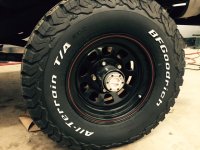Hmm, sure fooled me. But that's the fickleness of just going by looks.
Just to be sure though, overall width of a wheel is INSIDE the bead edge, so a measurement taken at the outer lip is not quite correct. If you put the tape down inside though, that 8" is still going to be within 1/8" or so of right on.
If that was on the outside edge though, check how deep the lips are and see if that takes it down some. Usually that's only in the 1/2" range or less, but some wheels do have deeper curled lips than others.
Either way, still worth fiddling about with pressures. That 50 psi is typical of a modern truck tire, and would normally dictate you don't go below 25 or so for safety, but since this is likely a much lighter load than they're rated for, I still think you're safe to 20.
But the bottom line is tire wear (or the chalk line check) rather than either comfort or looking at crowns or bows or bulged sidewalls.
If the chalk line does not wear off all the way to the edge of the tread, or at least within a 1/4" of it, then either there's too much air, or just too stiff of a sidewall. That last is very common too these days, what with larger and higher load range tires the norm. Even our heavy-ish 4000 lb rigs don't begin to stress them out. Heck, with some of the tires we use, you can run them empty and not always notice extra bulge at the bottom!
The good news is that if you run them flat, you don't usually hurt the wheel. The bad news is that it's harder to tell by looks and you should check pressures now and then, and they're not always the best riding or wearing tires for our applications.
Paul











